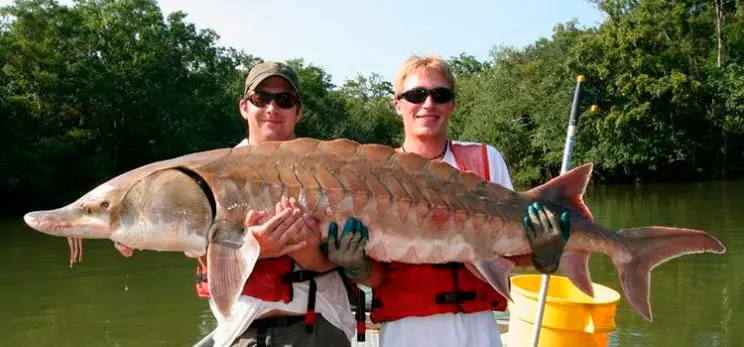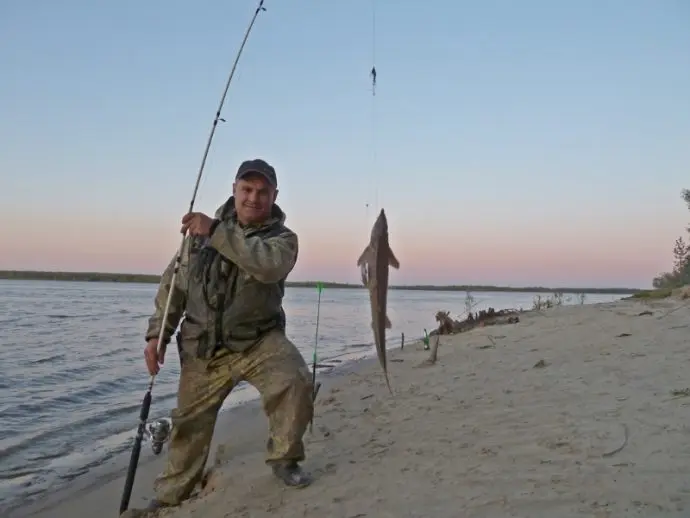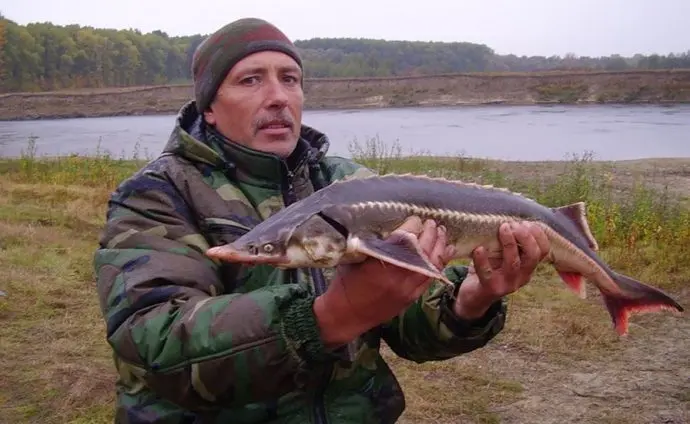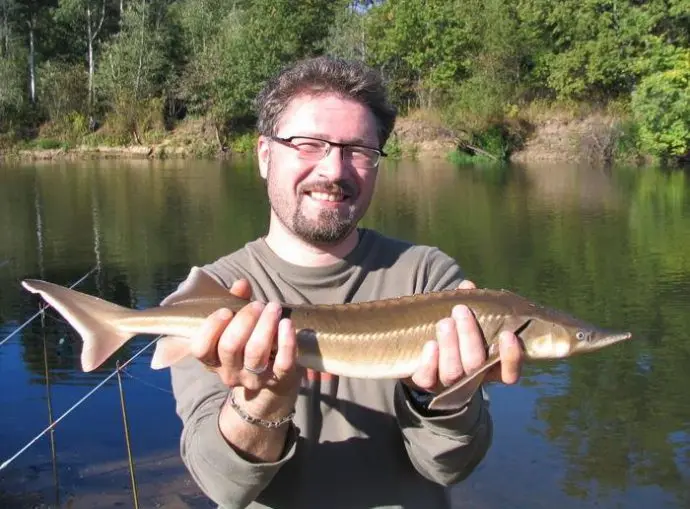Contents

The sterlet belongs to the sturgeon family of fish species. In the recent past, it could be found in such rivers as the Seversky Donets, Lopan and in the Kharkov River. In other words, the sterlet was caught even on medium and small rivers, which indicates its huge population of those times. At the moment, it is listed in the Red Book and has become a rarity even in the reservoirs of Russia, where there used to be a huge amount of it.
In some regions, sterlet fishing is prohibited altogether. In Russia, it can be caught, but only under a special license, which can somehow protect this fish from uncontrolled fishing. It would be a pity if this fish disappears for good. In this regard, I would like to appeal to anglers with a huge request that they do not catch more than they should.
Sterlet is characterized by the presence of valuable and tasty meat, as well as black caviar. Poachers do not think about the fact that the rate of its disappearance is quite high, because they care about their well-being and profit. Only uncontrolled fishing, as well as fishing for the sake of black caviar, endangered its existence. Moreover, black caviar hunters simply destroy the future offspring of this fish.
This article contains information that will help you decide on bait, tackle, places where sterlet can be found and the best time to fish. At the same time, it is desirable that anglers do not catch small sterlet, but release it. In Russia, it is not allowed to choose sterlet from water bodies, the size of which is less than 31 cm and weighs 250 g or less.
Tackle for catching sterlet

As a rule, it is caught with bottom gear, such as regular donks, rubber bands or carp rigs. The same requirements are imposed on all gear, although the sterlet is not alarmed by coarse equipment. The main condition is that the tackle has strength sufficient to fight large specimens. Although, recently it is hardly possible to see a large individual.
Fishing line and leash
For catching it enough fishing line, 0,3 mm thick. With the help of such a fishing line, you can catch a fairly large specimen, especially since the fish does not offer significant resistance. A fishing line with a diameter of 0,2-0,25 mm is suitable as a leash. It is possible to use a stronger, braided fishing line.
Hook
The main requirement for a hook is its sharpness. For sterlet fishing, you can use hooks No. 5-7. The length of the forearm does not play a special role.
Cargo
Due to the fact that fishing is carried out in the current, the load must have an appropriate weight, otherwise the tackle will be carried away by the current. It is better to choose a flat sinker, weighing from 50 to 100 grams. Such a sinker quickly rises from the bottom, which reduces the likelihood of hooks. It does not stretch along the bottom when pulling up, but plans at a certain height. This does not mean at all that other forms of weights cannot be used. It all depends on the nature of the reservoir.
Bait

For catching sterlet, baits such as:
- live;
- earthworm;
- muckworm;
- maggot;
- creep out.
According to experienced anglers, the sterlet prefers the worm more than any other bait. Even if you take a live bait, you can expect fewer bites on it than on a worm, especially since a large sterlet takes a live bait, so bites should be expected for a long time. Live bait is selected within 3-5cm. As for maggot, it is better to use it in combination with a worm.
Moreover, the appearance of the worm does not play any role, and the sterlet equally actively takes both the creeping out and the earth or dung worm. As a rule, only one worm is put on the hook, but not with a stocking, but pierced in some places. The result is a very appetizing, wriggling bait.
A big crawl is not needed, despite the fact that the sterlet’s mouth is not small. The most effective fishing is obtained when using a crawl of medium size.
Catching Sterlids on Zakydushki | Catching Sterlids on Rucheinyka | 1080p | “BF”-No. 41
Where to catch sterlet

To catch fish, especially such as sterlet, you should decide on a promising place. Most importantly, you need to know how to determine that this place can give sterlet bites. Otherwise, counting on at least some kind of catch does not make sense.
It is quite clear that it is not so easy to determine a catchy place, especially since every angler can keep such an interesting place a secret. The catchability of the place will depend on weather conditions, as well as the water level in the river. Where to look for sterlet? Sterlet can be located where a deep place (pit) is located. If the location of the pit is determined, then you need to find a way out of this pit. The place opposite the exit from the pit will be the most promising. She regularly leaves the hole and moves to shallow water. If you throw a few tackles, then the chances of seeing how the sterlet peck will increase.
In spring, as well as in summer, sterlet, depending on the water level in the river, can be located at different distances from the shore. If there is enough water, then it can come very close to the shore, in search of living creatures washed out of the coastal land. In such conditions, the sterlet can be caught with an ordinary float rod.
If there is little water in the river, then the sterlet can settle in the pit and wait for the period when the water level finally rises. Despite this, she leaves her hiding place in search of food, but she will not come close to the shore. As a rule, a drop in the water level in a reservoir makes any fish alert. In such conditions, there is a limitation in the activity of fish, as it is busy searching for other, deeper places.
With the advent of autumn, the sterlet practically does not come out of the pits and only occasionally can be found closer to the coast in September-October. And then this is possible when warm weather sets in and the upper layer of water warms up.
At a normal water level, the sterlet can stay at a distance of 50-100 meters from the shore, and during periods of high water it can approach the shore up to 25 or even 10 meters. With enough water, the sterlet leads an active lifestyle.
To profit, the sterlet examines areas bordering stagnant water. In such places, insect larvae, insects and worms that have escaped from the current settle.
In areas where there is no current, the sterlet should not be searched, as it prefers to stick to areas with a current. When visiting the borders of a fast current and standing water, the sterlet still adheres to this border and does not enter the area of standing water.
The sterlet comes out of the pits only in the morning, and in the evening it returns to the depth again. Going to the shallows, she chooses areas located at a distance of 40 meters from the coast, or even more. This is provided that there is an optimal amount of water in the reservoir.
The sterlet prefers to stay in flocks, therefore, having caught one individual, you can safely count on a series of bites. At the same time, you need to return the bait to the catchable place very quickly, otherwise it can quickly leave this place. If the sterlet finds the bait lying on the bottom, it will certainly want to swallow it.
When to catch sterlet

They begin to catch sterlet from early spring, and its fishing ends in late autumn. In winter, it is located at a depth of up to 25 meters and practically does not feed all winter. Therefore, catching it in winter is impossible due to the passive behavior of the fish. Despite this, there are cases of sterlet capture in winter. But this exception has nothing to do with the regularity. Most likely, this is due to warming, when the above-zero ambient temperature lasts for a long time.
After her spawning, and this is the end of spring, the most interesting period of sterlet fishing begins. It is no exception, and after spawning, like any other fish, the sterlet begins to feed heavily. With the beginning of the decline in the water level in the river, the anadromous sterlet rolls into the lower reaches of the rivers, and only the local sterlet remains in the field, which spawns and lives on its territory.
This fish is caught around the clock. At the same time, the maximum activity occurs at night. Despite this, in the morning, afternoon and evening, its activity decreases very slightly. In this regard, night fishing for sterlet is prohibited in many regions. It is allowed to catch it only during daylight hours. Although sometimes, during the day it is caught more actively than at night.
In spring and autumn, its activity is almost the same throughout the day, and sometimes during daylight hours its activity is higher due to warming up of the water, especially in the afternoon.
Throughout the summer, it is caught with bottom gear or with an elastic band. At a high water level, sterlet can be found 30 meters from the shore. With the advent of autumn, she goes to the pits. Therefore, it can be caught at the exits from the pits, which are located at a considerable distance from the coast (60-70 meters).
Fishing is one of the most interesting and exciting types of recreation. I wish fishing didn’t go from being a recreation to a constant and relentless effort to find fish. This is due to the fact that there are more and more fishermen, and fewer and fewer fish, especially since fishing tools are becoming more and more perfect. Due to the problems associated with providing humanity with food, fish are caught in huge, sometimes uncontrolled quantities. Moreover, the problem is global in nature and applies to both large and small water bodies.
Video “Catching a sterlet on a rubber band”
Catching a sterlet on a donk rubber band video (caught and released) – Clip
Video “Making equipment for a sterlet snack”
Making equipment for a snack on a sterlet









